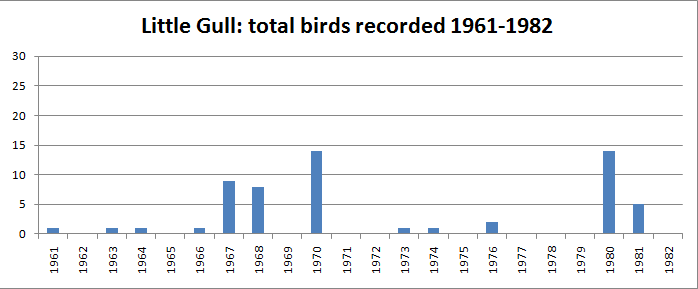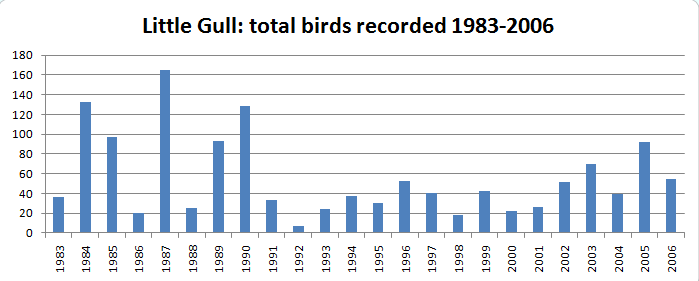Hydrocoloeus minutus (Larus minutus)
Passage migrant.
Little Gulls breed in lowland fresh water habitats throughout the temperate middle and northern latitudes of the Western Palearctic. They have increased in British and Irish offshore waters since the 1960’s, probably coming from the Baltic and North West Russian breeding populations.
Formerly rare in Pembrokeshire, Mathew (1894) knowing of just one occurrence of two birds at Tenby in 1892, Lockley et al (1949) being able to only add one more record of a single bird seen near St David’s on the 12th September 1927. Subsequent records date from 1961, increasing in line with other parts of Britain and Ireland.
Total birds recorded 1961 – 1981.
 Most of these records came from Skokholm but some from Skomer, Mullock Bridge, Ramsey and South Bishop. Thereafter, observer cover increased and more attention was paid to the offshore waters, with an increasing time being devoted to seawatching.
Most of these records came from Skokholm but some from Skomer, Mullock Bridge, Ramsey and South Bishop. Thereafter, observer cover increased and more attention was paid to the offshore waters, with an increasing time being devoted to seawatching.
Total birds recorded 1983 – 2006.

Most were noted between the 10th July and 31st December, being recorded all around the coast from Cemaes Head to Wiseman’s Bridge, within the estuaries of the Teifi, Nevern and Cleddau and out to sea as far as Grassholm and The Smalls. However the bulk of the records were from Strumble Head, partly because of its geographic position but also because of the intensity of prolonged observations conducted there.
New high county day totals were experienced at Strumble Head in the period 28th October – 24th December between 1984 and 1990, viz. 69 on the 24th December 1984, 75 on the 10th November 1985, 76 on the 13th November 1987 and 47 on the 28th October 1990. All occurred during onshore gales.
The incidence of onshore gales in late October to December diminished during the period 1991 – 2002 and the number of Little Gulls seen dropped, with peak numbers down to 16 on the 14th November 1993, 12 on the 29th October 1996, 10 on the 6th November 1999 and 15 on the 29th November 2002. However, the “right conditions” occurred in 2003 and 46 Little Gulls passed on the 15th November.
The Little Gull has so far been predominantly a coastal bird in Pembrokeshire. The only fresh water records concern singles at Bosherston on the 10th September 1983, Brandy Brook on the 21st March 1991, Pembroke Mill Ponds on the 4th April 1990 and 31st October – 4th November 2004, Pen Beri Reservoir on the 20th December 1997, Withybush airfield on the 21st October 1988, Llys y fran Reservoir on the 30th September 1976 and 1st April 2006.
The marked spring passage of 1973 – 75 noted in Wales by Lovegrove et al (1994) was not recorded in Pembrokeshire. Spring occurrences in the county have been few and sporadic with singles (once two) being recorded in 12 years between 1973 and 2005, with a total of 24 birds involved, passing between the 25th March and 26th June.
There are 46 records for mid winter, that is January to February, mostly involving one or two birds at a time but with three Skokholm on the 6th February 1998, three Strumble Head on the 10th February 1985, six there on the 24 January 2002 and seven on the 13th January 2004, six Ramsey Sound on the 19th January 2004 and 11 Fishguard Harbour on the 13th February 2005. Most were one day occurrences but one was at Newgale for 26 days in January to February 1990 and another at Fishguard Harbour for 63 days from the beginning of January 1995.
Graham Rees
References
LOCKLEY. R. M, INGRAM. C. S. and SALMON. H. M.1949. The birds of Pembrokeshire, West Wales Field Society.
LOVEGROVE. R, WILLIAMS . G. & WILLIAMS. I. 1994. Birds in Wales, T & A. D. Poyser Ltd, London.
MATHEW. M. 1894. The birds of Pembrokeshire and its islands, R. H. Porter.
 Thursday, October 24, 2013 at 5:53PM
Thursday, October 24, 2013 at 5:53PM  1949 BoP in
1949 BoP in  Little Gull
Little Gull 




